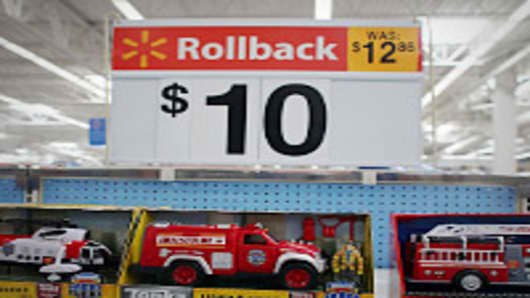Rollback those fears about Wal-Mart'sprice cuts—unless you are one of its suppliers or competitors, that is.
The world's largest retailer has been trying to shore up its discount image by advertising it will be rolling back prices on roughly 10,000 items, mostly food and other staples. Although Wal-Mart Stores is not disclosing the size of the price cuts, analysts have tried to gauge their impact, and what this says about its business.
Citi analyst Deborah Weinswig conducts a "Weekly Rollback Roundup" and her research found Wal-Mart had stepped up its reductions in the most recent week. The average rollback was a 20.5 percent discount for the week ended April 1, compared with 16.8 percent in the week ended March 26.
But Weinswig reiterated her "buy" rating on Wal-Mart shares Friday, and said she expects the company will benefit from the steps it's taking on prices in 2010.
"Food-at-home deflation is abating, and retailers expect inflation to return in 2010," Weinswig wrote in a research note.
"However we are concerned food retailers will find it difficult to pass on food inflation given the high unemployment rate, weak consumer spending on non-discretionary items, and intense price competition. Therefore, costs will likely increase and pricing power could be weak, which will pressure margins."
Although consumers already associate Wal-Mart with low prices, the company saw its sales in the fourth quarter weaken slightly. Many retail industry analysts saw this as a sign that the middle- and upper-income consumers, who had flocked to the store during the dark days of the Great Recession, were getting more comfortable and returning to the stores that they had visited prior to the economic downturn.
And certainly, this week's batch of monthly chain store sales reportsshowed gains at stores that may have lost customers to Wal-Mart last year. For example, Kohl's saw its same-store sales in March jump 22.5 percent from last year, nearly double the gain that analysts were expecting. It's unclear how Wal-Mart fared in March as the company no longer reports monthly sales figures.
Wall Street Strategies analyst Brian Sozzi said Wal-Mart's move harkens back to the classic Sam Walton model.
"By no means am I willing to bet against Wal-Mart here," Sozzi said. "I think, actually, this could be good sign that they have found further places across their supply chain to reduce costs."
But those cost cuts will likely put pressure on companies like Heinz, Campbell Soup and Clorox, which will probably feel a squeeze from Wal-Mart's actions.
Sozzi expects that as Wal-Mart reduces prices on consumables, it will make up the margin hit up by selling more private-label goods, selling more food volume at lower purchasing costs, and selling items in high-margin departments such as home goods.
As for Wal-Mart's competitors, Weinswig remains cautious on the stocks of the food retailers, and she reiterated her "sell" rating on Safeway, citing the company's stock price. According to Weinswig, Safeway is currently trading at 15-times future earnings, which is higher than its 10-year average multiple.
Backing up this sentiment was a survey conducted by GfK Research for the Private Label Manufacturers Association in February that showed the average supermarket shopper isn't sold on the economic recovery yetand plans to stick with private-label products as a way to lower grocery bills.
There has been a lot of talk lately about whether the recession has made any lasting changes on consumer behavior. Perhaps the most lasting impact will be felt in the grocery aisle, and Wal-Mart's price cuts may be just one reaction to this new normal.
More from Consumer Nation:
- Want to Pick a Winner in Retail? 3 Brands for the Long Haul
- J. Crew CEO: Retailers Have Come Back, Not Consumers
- Facebook Lowers the Bar on Brand Loyalty
Questions? Comments? Email us at consumernation@cnbc.com



